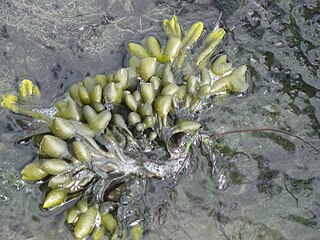
The littoral zone or nearshore is the part of a sea, lake, or river that is close to the shore. In coastal environments, the littoral zone extends from the high water mark, which is rarely inundated, to shoreline areas that are permanently submerged. The littoral zone always includes this intertidal zone, and the terms are often used interchangeably. However, the meaning of littoral zone can extend well beyond the intertidal zone.

Tide pools or rock pools are shallow pools of seawater that form on the rocky intertidal shore. Many of these pools exist as separate bodies of water only at low tide.

Fucus is a genus of brown algae found in the intertidal zones of rocky seashores almost throughout the world.

Ascophyllum nodosum is a large, common cold water seaweed or brown alga (Phaeophyceae) in the family Fucaceae, being the only species in the genus Ascophyllum. It is a seaweed that only grows in the northern Atlantic Ocean, also known in localities as feamainn bhuí, rockweed, Norwegian kelp, knotted kelp, knotted wrack or egg wrack. It is common on the north-western coast of Europe including east Greenland and the north-eastern coast of North America, its range further south of these latitudes being limited by warmer ocean waters.

Alaria esculenta is an edible seaweed, also known as dabberlocks or badderlocks, or winged kelp. It is a traditional food along the coasts of the far north Atlantic Ocean. It may be eaten fresh or cooked in Greenland, Iceland, Scotland and Ireland. It is the only one of twelve species of Alaria to occur in both Ireland and in Great Britain.

The intertidal zone, also known as the foreshore or seashore, is the area above water level at low tide and underwater at high tide. This area can include several types of habitats with various species of life, such as seastars, sea urchins, and many species of coral. Sometimes it is referred to as the littoral zone, although that can be defined as a wider region.

Fucus serratus is a seaweed of the north Atlantic Ocean, known as toothed wrack or serrated wrack.

Intertidal ecology is the study of intertidal ecosystems, where organisms live between the low and high tide lines. At low tide, the intertidal is exposed whereas at high tide, the intertidal is underwater. Intertidal ecologists therefore study the interactions between intertidal organisms and their environment, as well as between different species of intertidal organisms within a particular intertidal community. The most important environmental and species interactions may vary based on the type of intertidal community being studied, the broadest of classifications being based on substrates—rocky shore and soft bottom communities.

Fucus spiralis is a species of seaweed, a brown alga, living on the littoral shore of the Atlantic coasts of Europe and North America. It has the common names of spiral wrack and flat wrack.

Pelvetia canaliculata, the channelled wrack, is a very common brown alga (Phaeophyceae) found on the rocks of the upper shores of Europe. It is the only species remaining in the monotypic genus Pelvetia. In 1999, the other members of this genus were reclassified as Silvetia due to differences of oogonium structure and of nucleic acid sequences of the rDNA.

A rocky shore is an intertidal area of seacoasts where solid rock predominates. Rocky shores are biologically rich environments, and are a useful "natural laboratory" for studying intertidal ecology and other biological processes. Due to their high accessibility, they have been well studied for a long time and their species are well known.

Corallina officinalis is a calcareous red seaweed which grows in the lower and mid-littoral zones on rocky shores.

Semibalanus balanoides is a common and widespread boreo-arctic species of acorn barnacle. It is common on rocks and other substrates in the intertidal zone of north-western Europe and both coasts of North America.

Laminaria digitata is a large brown alga in the family Laminariaceae, also known by the common name oarweed. It is found in the sublittoral zone of the northern Atlantic Ocean.

Himanthalia elongata is a brown alga in the order Fucales, also known by the common names thongweed, sea thong and sea spaghetti. It is found in the north east Atlantic Ocean and the North Sea.

Fucus gardneri is a species of seaweed, a brown alga living on the littoral shore of the Pacific coasts of North America. It has the common names of rockweed and bladderwrack.

Fucus ceranoides is a species of brown algae found in the littoral zone of the sea shore.

Ceramium shuttleworthianum is a small marine red alga.
Susan Brawley is a marine ecologist at the University of Maine known for her research on algae, especially algal reproduction. She was elected a fellow of the American Association for the Advancement of Science in 2012.



















